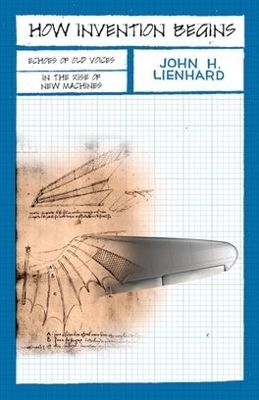
How Invention Begins
Echoes of Old Voices in the Rise of New Machines
Seiten
2008
Oxford University Press Inc (Verlag)
978-0-19-534120-1 (ISBN)
Oxford University Press Inc (Verlag)
978-0-19-534120-1 (ISBN)
More a prehistory of invention and a biography of ideas and their originators than an exposition of technological advances, the stories explicate the evolution of ideas that eventually result in the historic naming of an inventor.
Invention --that single leap of a human mind that gives us all we create. Yet we make a mistake when we call a telephone or a light bulb an invention, says John Lienhard. In truth, light bulbs, airplanes, steam engines--these objects are the end results, the fruits, of vast aggregates of invention. They are not invention itself. In How Invention Begins, Lienhard reconciles the ends of invention with the individual leaps upon which they are built, illuminating the vast web of individual inspirations that lie behind whole technologies. He traces, for instance, the way in which thousands of people applied their combined inventive genius to airplanes, railroad engines, and automobiles. As he does so, it becomes clear that a collective desire, an upwelling of fascination, a spirit of the times--a Zeitgeist --laid its hold upon inventors. The thing they all sought to create was speed itself. Likewise, Lienhard shows that when we trace the astonishingly complex technology of printing books, we come at last to that which we desire from books--the knowledge, the learning, that they provide. Can we speak of speed or education as inventions? To do so, he concludes, is certainly no greater a stretch than it is to call radio or the telephone an "invention." Throughout this marvelous volume, Lienhard illuminates these processes, these webs of insight or inspiration, by weaving a fabric of anecdote, history, and technical detail--all of which come together to provide a full and satisfying portrait of the true nature of invention.
Invention --that single leap of a human mind that gives us all we create. Yet we make a mistake when we call a telephone or a light bulb an invention, says John Lienhard. In truth, light bulbs, airplanes, steam engines--these objects are the end results, the fruits, of vast aggregates of invention. They are not invention itself. In How Invention Begins, Lienhard reconciles the ends of invention with the individual leaps upon which they are built, illuminating the vast web of individual inspirations that lie behind whole technologies. He traces, for instance, the way in which thousands of people applied their combined inventive genius to airplanes, railroad engines, and automobiles. As he does so, it becomes clear that a collective desire, an upwelling of fascination, a spirit of the times--a Zeitgeist --laid its hold upon inventors. The thing they all sought to create was speed itself. Likewise, Lienhard shows that when we trace the astonishingly complex technology of printing books, we come at last to that which we desire from books--the knowledge, the learning, that they provide. Can we speak of speed or education as inventions? To do so, he concludes, is certainly no greater a stretch than it is to call radio or the telephone an "invention." Throughout this marvelous volume, Lienhard illuminates these processes, these webs of insight or inspiration, by weaving a fabric of anecdote, history, and technical detail--all of which come together to provide a full and satisfying portrait of the true nature of invention.
John H. Lienhard is M.D. Anderson Professor Emeritus of Mechanical Engineering and of History at the University of Houston. He is the author and host of "The Engines of Our Ingenuity," a daily radio essay on invention and creativity heard nationally on Public Radio and internationally on the Armed Forces Network. He is also the author of the book The Engines of Our Ingenuity: An Engineer Looks at Technology and Culture. Books by the same author: Inventing Modern The Engines of Our Ingenuity
Preface
Part I: Priority and Aprioity
Part II: Steam and Speed
Part III: Writing and Showing
Part IV: Views Through a Wider Lens
Notes
Illustration Credits
Index
| Erscheint lt. Verlag | 5.6.2008 |
|---|---|
| Zusatzinfo | numerous halftones and figures |
| Verlagsort | New York |
| Sprache | englisch |
| Maße | 234 x 158 mm |
| Gewicht | 408 g |
| Themenwelt | Geschichte ► Teilgebiete der Geschichte ► Technikgeschichte |
| Mathematik / Informatik ► Mathematik ► Geschichte der Mathematik | |
| Naturwissenschaften | |
| Sozialwissenschaften | |
| ISBN-10 | 0-19-534120-1 / 0195341201 |
| ISBN-13 | 978-0-19-534120-1 / 9780195341201 |
| Zustand | Neuware |
| Haben Sie eine Frage zum Produkt? |
Mehr entdecken
aus dem Bereich
aus dem Bereich
Buch | Softcover (2024)
Lehmanns Media (Verlag)
19,95 €
Digitalisierung neu denken für eine gerechte Gesellschaft
Buch | Hardcover (2023)
Quadriga (Verlag)
20,00 €
Vom Perceptron zum Deep Learning
Buch | Softcover (2022)
Springer Vieweg (Verlag)
19,99 €


